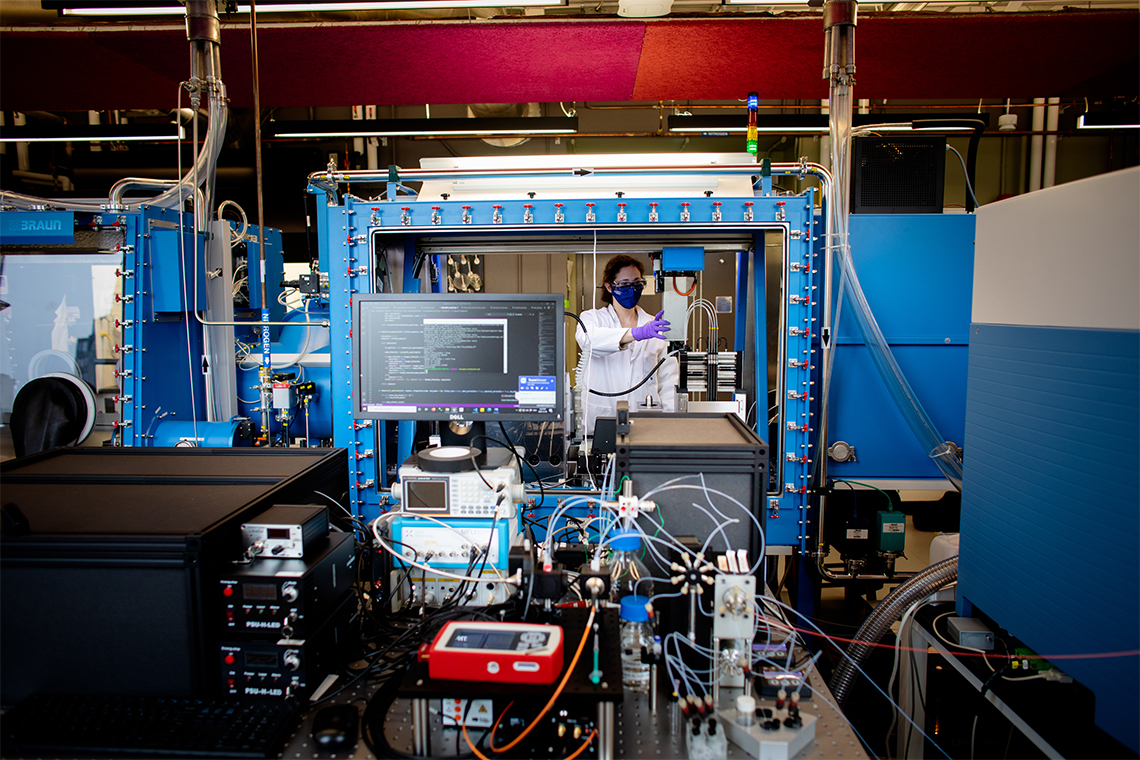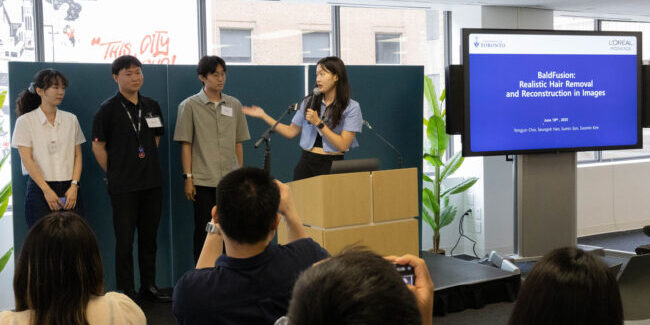The University of Toronto has been awarded a $200-million grant from the Canada First Research Excellence Fund (CFREF) to revolutionize the speed and impact of scientific discovery through its Acceleration Consortium.
The funding – the largest federal research grant ever awarded to a Canadian university – will support the consortium’s work on ‘self-driving labs’ that combine artificial intelligence, robotics and advanced computing to discover new materials and molecules in a fraction of the usual time and cost. Applications include everything from life-saving medications and biodegradable plastics to low-carbon cement and renewable energy.
Researchers in the consortium recently revealed that they used the technology to develop a potential cancer drug in just 30 days – a process that typically takes years, or even decades.
“The University of Toronto is grateful for this significant investment in artificial intelligence-driven research and innovation, which promises to improve the lives of Canadians and those of people around the world,” said U of T President Meric Gertler.
“The federal government’s critical support of this initiative builds on years of strategic planning and decisions in this space by the University and the federal government, including the 2017 launch of the Pan-Canadian Artificial Intelligence Strategy that helped cement Toronto’s status as a global hub for a revolutionary technology.
“This is the next step in achieving that bold vision.”
Launched as an Institutional Strategic Initiative in 2021, the Acceleration Consortium brings together partners from academia, government and industry who are accelerating the discovery of materials and molecules needed for a sustainable future. The consortium aims to reduce the time and cost of bringing advanced materials to market, from an average of 20 years and $100 million to as little as one year and $1 million.
The multidisciplinary, collaborative team that makes up the Acceleration Consortium includes several U of T Engineering researchers working at the leading edge of new materials discovery. Examples include:
- Professor Jason Hattrick-Simpers (MSE) — Hattrick-Simpers and his team are in the process of building a new device they’ve named the ‘Sputtertron.’ The system will not only be capable of creating new alloys via a chemical deposition process known as sputtering, but it will also be able autonomously characterize and analyze the electronic properties of those new alloys. Those properties will then be used by the model to imagine the next material to be made, and direct its creation, all without any human intervention — the approach is an example of a ‘self-driving lab.’
- Professor Yu Zou (MSE) — Zou leads the University of Toronto’s first metal additive manufacturing laboratory. The technology is similar to 3D printing, except that it focuses on components made of metal rather than plastic. Additive manufacturing significantly reduces production time, material cost and energy consumption when producing objects. Examples include aerospace engine components, tooling parts for automotive production, critical components for nuclear reactors and joint implants.
- Professor Gisele Azimi (MSE) — Azimi and her team at U of T Engineering’s Laboratory for Strategic Materials have proposed a new, more sustainable method to mine valuable metals from lithium-ion batteries that have reached the end of their useful lifespan. Besides lithium itself, examples of these metals include cobalt, nickel and manganese. The work could enhance both the security and efficiency of supply chains for these critical materials.
- Professor David Sinton (MIE) —Electrochemistry — the use of electricity to drive forward a chemical reaction — can be used to convert captured carbon into valuable products, such as fuels or industrial chemicals. Sinton and his collaborators are developing advanced electrocatalysts that can lower the energy cost of these reactions and increase the economic incentives to capture and recycle carbon.
“Our goal is to accelerate science,” said Acceleration Consortium Director Alán Aspuru-Guzik, a professor in the departments of chemistry and computer science in the Faculty of Arts & Science who is a CIFAR AI Chair at the Vector Institute for Artificial Intelligence.
“To do that, we realized we need to take a cue from self-driving cars and extended that concept to a self-driving lab, which uses AI and automation to carry out more experiments in a smarter way.
“We’ve essentially supercharged the process of scientific discovery.”
The CFREF funding, along with additional support from U of T – which includes an investment of $130 million to expand facilities to house the Acceleration Consortium’s state-of-the-art labs at the Lash Miller Chemical Laboratories building on the St. George campus – will help secure the researchers, spaces and partnerships needed to build a world-leading centre for accelerated materials discovery and innovation.
The funding will also help the consortium rapidly create high quality datasets to better train AI models and validate the model’s predictions in real time. That, in turn, will dramatically accelerate the discovery and development of molecules and materials for a wide range of industries.
With a strong plan of equity, diversity and inclusion guiding project implementation and research design, the initiative will commercialize ethically designed technologies and materials to benefit society and train today’s scientists with the skills they need to advance the emerging field of accelerated materials discovery. It will also allow the consortium to examine critical issues regarding the application of the technology, including from environmental and Indigenous perspectives.
“With this funding – which enabled us to obtain matching commitments of about $300 million from all our partners – we are talking about half a billion dollars of investments, said Aspuru-Guzik, who joined U of T from Harvard University in 2018 as a Canada 150 Research Chair in Theoretical and Quantum Chemistry and is one of a growing number of global experts at the Acceleration Consortium.
“This will help us make the Greater Toronto Area and Canada world leaders in AI-frontier discovery – we have no excuse not to be after this project.”
The Acceleration Consortium comprises nearly 100 researchers – and is hiring many more – across a wide variety of disciplines, including AI, computer science, mathematics, chemistry, economics, engineering, materials science, mechatronics, biology, pharmacology, robotics, technoscience and more. It also includes 30 partners from the private and public sector, including the University of British Columbia, a lead partner on the grant.
CFREF aims to boost the strengths of Canadian postsecondary institutions so that they can achieve global success in research areas that create long-term social and economic advantages for Canada. It invests approximately $200 million per year (or approximately $1.4 billion over a competition cycle of seven years) through a highly competitive peer review process.
“We named this a consortium and not an institute for a reason,” Aspuru-Guzik said. “We are a global effort with its homebase in Toronto that involves academia, government and industry.
“A core goal of our efforts is to spin out the next generation of companies that will develop the materials for the 21st century here in Canada. This, in turn, will help make the GTA the economic epicentre for this field.”
This story was originally published on U of T News.




